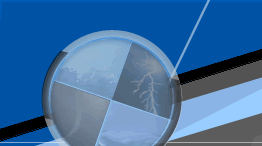|
Information
- Winter Weather - Regions
From the Mid-Atlantic Coast to New England
The classic storm is called a Nor'easter. A low pressure area off
the Carolina coast strengthens and moves north. Wind-driven waves
batter the coast from Virginia to Maine, causing flooding and severe
beach erosion. The storm taps the Atlantic's moisture-supply and
dumps heavy snow over a densely populated region. The snow and wind
may combine into blizzard conditions and form deep drifts paralyzing
the region. Ice storms are also a problem. Mountains, such as the
Appalachians, act as a barrier to cold air trapping it in the valleys
and adjacent low elevations. Warm air and moisture moves over the
cold, trapped air. Rain falls from the warm layer onto a cold surface
below becoming ice.
Along the Gulf Coast and Southeast
This region is generally unaccustomed to snow, ice, and freezing
temperatures. Once in a while, cold air penetrates south across
Texas and Florida, into the Gulf of Mexico. Temperatures fall below
freezing killing tender vegetation, such as flowering plants and
the citrus fruit crop. Wet snow and ice rapidly accumulate on trees
with leaves, causing the branches to snap under the load. Motorists
are generally unaccustomed to driving on slick roads and traffic
accidents increase. Some buildings are poorly insulated or lack
heat altogether. Local municipalities may not have available snow
removal equipment or treatments, such as sand or salt, for icy roads.
In the Midwest and Plains
Storms tend to develop over southeast Colorado in the lee of the
Rockies. These storms move east or northeast and use both the southward
plunge of cold air from Canada and the northward flow of moisture
from the Gulf of Mexico to produce heavy snow and sometimes blizzard
conditions. Other storms affecting the Midwest and Plains intensify
in the lee of the Canadian Rockies and move southeast. Arctic air
is drawn from the north and moves south across the Plains and Great
Lakes. Wind and cold sometimes combine to cause wind chill temperatures
as low as 70F below zero. The wind crosses the lakes, tapping its
moisture and forming snow squalls and narrow heavy snow bands. This
is called "lake-effect snow."
From the Rockies to the West Coast...Strong storms crossing the
North Pacific sometimes slam into the coast from California to Washington.
The vast Pacific provides an unlimited source of moisture for the
storm. If cold enough, snow falls over Washington and Oregon and
sometimes even in California. As the moisture rises into the mountains,
heavy snow closes the mountain passes and can cause avalanches.
The cold air from the north has to filter through mountain canyons
into the basins and valleys to the south. If the cold air is deep
enough, it can spill over the mountain ridge. As the air funnels
through canyons and over ridges, wind speeds can reach 100 mph,
damaging roofs and taking down power and telephone lines. Combining
these winds with snow results in a blizzard.
In Alaska
Wind-driven waves from intense storms crossing the Bering Sea produce
coastal flooding and can drive large chunks of sea ice inland destroying
buildings near the shore. High winds, especially across Alaska's
Arctic coast, can combine with loose snow to produce a blinding
blizzard and wind chill temperatures to 90F below zero! Extreme
cold (-40F to -60F) and ice fog may last a week at a time. Heavy
snow can impact the interior and is common along the southern coast.
With only brief glimpses of the winter sun across the southern horizon,
the snow accumulates through the winter months. In the mountains,
it builds glaciers, but the heavy snow accumulations can also cause
avalanches or collapse roofs of buildings. A quick thaw means certain
flooding. Ice jams on rivers can also cause substantial flooding.
Top | Back
| Next
|



